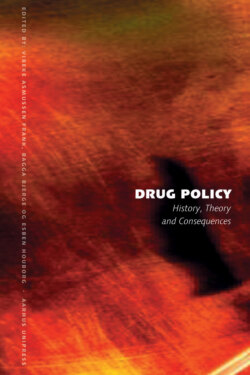Читать книгу Drug Policy - Группа авторов - Страница 13
Contributions of this volume
ОглавлениеAs mentioned at the beginning of this introduction, the contributions to this volume fall under three headings. The first concerns the development of drug policies in various institutional settings; the second concerns local drug policy; and the third puts Danish drug policy into a historical context and shows the USA as an example of a country in which drug policy has proliferated vastly.
As discussed above, Danish drug policy has seen a number of significant changes in recent years. The changes of formal drug policy in themselves make Danish drug policy an interesting topic of research. The first two contributions analyse the way drug policies vary as they are developed and practised in various institutional conditions. Charlotte Siiger analyses how drugs and drug policies are negotiated among staff in hostels for the homeless. Vibeke Asmussen Frank & Torsten Kolind analyse the balance between drug control and treatment practices in a prison setting. Both studies discuss how drug policies take form in practice. The next two contributions analyse the way in which drug policies are developed and carried out at local level in two Danish cities. The re-penalisation of possession of drugs for personal use and the much harder policy on cannabis might even be said to constitute a natural experiment, which it is very interesting to follow. Kim Møller’s contribution to this volume is one of the first analyses of this experiment. Helle Vibeke Dahl discusses how local control policy in a major city in Denmark influences the everyday lives of drug users, both as clients in methadone clinics and in relation to their use of city space as congregation points. Her contribution also shows that the various elements of drug policy (treatment and nuisance policy) are experienced by drug users as one and the same thing. The third and final section contains four contributions and deals with drug policy more on a macro level in terms of the historical development of modern Danish drug policy, with regard to legislation, law enforcement and treatment. In various ways the contributions by Jørgen Jepsen, Esben Houborg and Eric Jensen show the constitution and development of drug policies at a more structural level. Focusing on control policy Jørgen Jepsen discuss the development of modern Danish drug policy. Esben Houborg analyse how the new youth culture associated with the modern drug problem of the 1960ies became a major challenge for institutions responsible for handling deviance and producing social integration – the child- and youth welfare system, the psychiatric system and the prisons. And he shows how a separate drug treatment system emerged, partly because it was better suited to handle this new youth culture. The contribution by Eric Jensen shows the American version of how drug policy proliferates into all sorts of different policies and practices. These three contributions show that drug policy is affected not only by changes in drug control but also by policy developments occurring outside the traditional realm of drug policy. This is also the focus in Bagga Bjerge’s contribution where she analyses the effects of the large-scale structural reform of Danish social policy on local municipal drug policies.
Overall the contributions give insights into various levels of drug policy. It is not, however, the claim of this anthology to give a comprehensive account of Danish drug policy today. But we hope to show a number of significant developments within Danish drug policy and point to a number of problems related to the study of drug policies in general.
